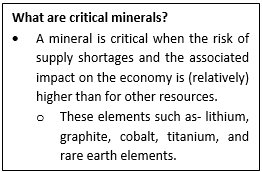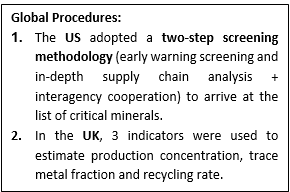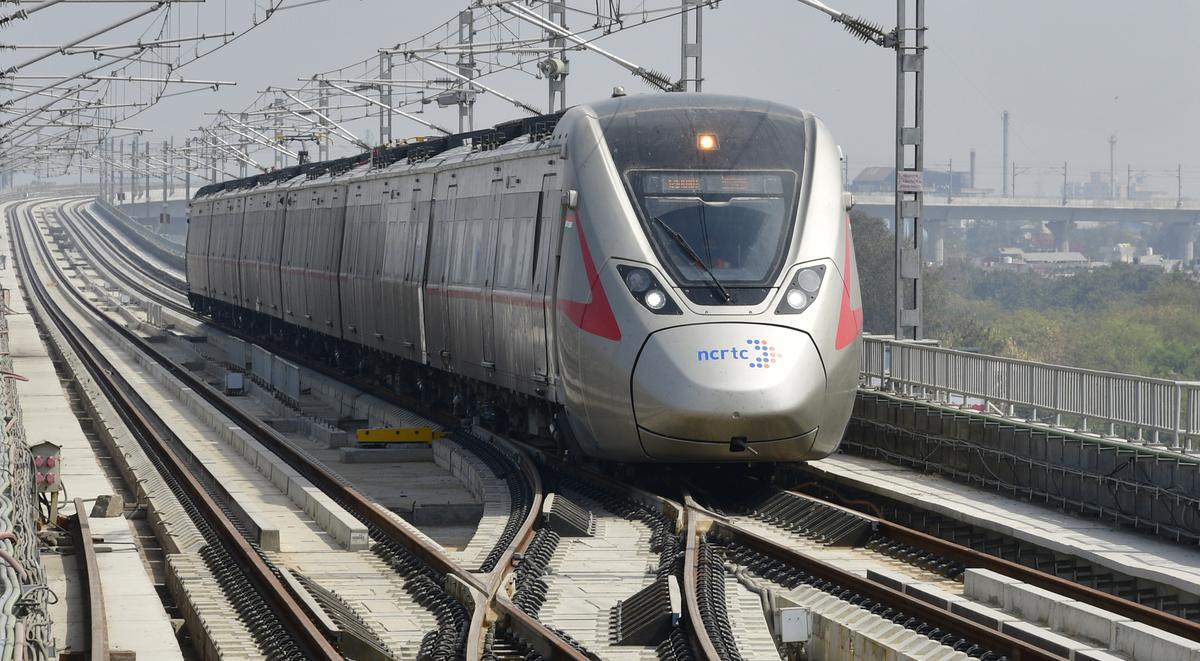- Courses
- GS Full Course 1 Year
- GS Full Course 2 Year
- GS Full Course 3 Year
- GS Full Course Till Selection
- Online Program
- GS Recorded Course
- NCERT (Recorded 500+ Hours)
- Polity Recorded Course
- Geography Recorded Course
- Economy Recorded Course
- AMAC Recorded Course
- Modern India, Post Independence & World History
- Environment Recoded Course
- Governance Recoded Course
- Science & Tech. Recoded Course
- International Relations and Internal Security Recorded Course
- Disaster Management Module Course
- Ethics Recoded Course
- Essay Recoded Course
- Current Affairs Recoded Course
- CSAT
- 5 LAYERED ARJUNA Mentorship
- Public Administration Optional
- ABOUT US
- OUR TOPPERS
- TEST SERIES
- FREE STUDY MATERIAL
- VIDEOS
- CONTACT US
Critical minerals
Critical minerals
09-12-2023
Context
- 20 blocks of critical minerals are currently being auctioned for commercial mining by the private sector.
- The mineral blocks contain lithium ore, which is used in batteries and electric vehicles.
Importance of critical minerals
- These minerals are critical to economic development and national securi
 ty, and their lack of availability/concentration of mining/processing in a few geographic locations could potentially lead to supply chain vulnerabilities.
ty, and their lack of availability/concentration of mining/processing in a few geographic locations could potentially lead to supply chain vulnerabilities. - Essential for the development of many industries, including high-tech electronics, telecommunications, transportation, and defense.
- It forms part of several strategic value chains including clean technology initiatives such as zero emission vehicles, wind turbines, solar panels, etc.
How does India currently get its supply of these minerals?
- In FY23, India imported 2,145 tonnes of lithium carbonate and lithium oxide.

- Lithium carbonate contains up to 19% lithium. Lithium oxide, which is usually converted to lithium hydroxide, contains 29% lithium.
- India, 100% import dependent for lithium and nickel demand.
Recent efforts by India to strengthen its critical minerals sector
- The Geological Survey of India (an associate agency of the Ministry of Mines) recently conducted a mineral survey in the Salal-Haimna areas (Reasi district, J&K) and estimated 5.9 million tonnes of lithium ore.
- A joint venture namely Khanij Bidesh India Ltd. (KABIL), is mandated to identify and acquire overseas mineral assets of critical and strategic nature (Lithium, Cobalt) to ensure supply side hedging.
- India was recently inducted into the Mineral Security Partnership (MSP), a US-led collaboration of 14 countries to accelerate global public and private investment in critical mineral supply chains.
Challenges for critical mineral supply chains
- China - China is an important player in critical mineral supply chains and has yet to overcome the effects of Covid-19, so India faces insufficient supply cuts.
- Russia-Ukraine War – Russia is a major producer of nickel, palladium, titanium sponge and scandium and Ukraine is a producer of titanium, the war disrupted supply chains.
- Power Shifts - Due to low supplies from Russia and China, developed countries have developed plans such as the Minerals Security Partnership (MSP) and the G7's Sustainable Critical Minerals Alliance.
- The MSP – India is not part of – brings countries together to build robust critical mineral supply chains needed for climate goals.
- Demand for green technologies - Since India lacks critical mineral demand for green technologies, it depends on other countries.
- Lack of private sector involvement in critical mining sectors.
- Lack of regular assessments of critical minerals to make them sustainable.
Way forward
- India needs to explore unexplored critical minerals. Currently, critical minerals can only be processed by the public sector. The Mines and Minerals (Development and Regulation) Act (MMDR) 1957 must therefore be amended to exclude critical minerals such as atomic minerals.
- The assessment of critical minerals for India needs to be updated every three years to keep pace with the changing domestic and global scenarios.
- Critical minerals must be identified, explored and mined as a matter of priority, as any delay could hinder India's emissions reduction and climate change mitigation efforts.
- Exploration of minerals should be encouraged, with special attention given to deep-seated minerals.


